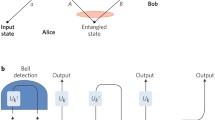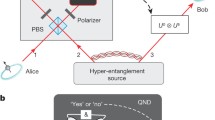Quantum teleportation — the transmission and reconstruction over arbitrary distances of the state of a quantum system — is demonstrated experimentally. During teleportation, an initial photon which carries the polarization that is to be transferred and one of a pair of entangled photons are subjected to a measurement such that the second photon of the entangled pair acquires the polarization of the initial photon. This latter photon can be arbitrarily far away from the initial one. Quantum teleportation will be a critical ingredient for quantum computation networks.





Similar content being viewed by others
References
Bennett, C. H. et al. Teleporting an unknown quantum state via dual classic and Einstein-Podolsky-Rosen channels. Phys. Rev. Lett. 70, 1895–1899 (1993).
Schrödinger, E. Die gegenwärtige Situation in der Quantenmechanik. Naturwissenschaften 23, 807–812; 823–828; 844–849 (1935).
Bennett, C. H. Quantum information and computation. Phys. Today 48(10), 24–30, (October1995).
Bennett, C. H., Brassard, G. & Ekert, A. K. Quantum Cryptography. Sci. Am. 267(4), 50–57, (October1992).
Mattle, K., Weinfurter, H., Kwiat, P. G. & Zeilinger, A. Dense coding in experimental quantum communication. Phys. Rev. Lett. 76, 4656–4659 (1996).
Kwiat, P. G. et al. New high intensity source of polarization-entangled photon pairs. Phys. Rev. Lett. 75, 4337–4341 (1995).
Hagley, E. et al. Generation of Einstein-Podolsky-Rosen pairs of atoms. Phys. Rev. Lett. 79, 1–5 (1997).
Schumacher, B. Quantum coding. Phys. Rev. A 51, 2738–2747 (1995).
Clauser, J. F. & Shimony, A. Bell's theorem: experimental tests and implications. Rep. Prog. Phys. 41, 1881–1927 (1978).
Greenberger, D. M., Horne, M. A. & Zeilinger, A. Multiparticle interferometry and the superposition principle. Phys. Today August, 22–29 (1993).
Tittel, W. et al. Experimental demonstration of quantum-correlations over more than 10 kilometers. Phys. Rev. Lett. (submitted).
Zukowski, M., Zeilinger, A., Horne, M. A. & Ekert, A. “Event-ready-detectors” Bell experiment via entanglement swapping. Phys. Rev. Lett. 71, 4287–4290 (1993).
Bose, S., Vedral, V. & Knight, P. L. Amultiparticle generalization of entanglement swapping.preprint.
Wootters, W. K. & Zurek, W. H. Asingle quantum cannot be cloned. Nature 299, 802–803 (1982).
Loudon, R. Coherence and Quantum Optics VI (eds Everly, J. H. & Mandel, L.) 703–708 (Plenum, New York, (1990)).
Zeilinger, A., Bernstein, H. J. & Horne, M. A. Information transfer with two-state two-particle quantum systems. J. Mod. Optics 41, 2375–2384 (1994).
Weinfurter, H. Experimental Bell-state analysis. Europhys. Lett. 25, 559–564 (1994).
Braunstein, S. L. & Mann, A. Measurement of the Bell operator and quantum teleportation. Phys. Rev. A 51, R1727–R1730 (1995).
Michler, M., Mattle, K., Weinfurter, H. & Zeilinger, A. Interferometric Bell-state analysis. Phys. Rev. A 53, R1209–R1212 (1996).
Zukowski, M., Zeilinger, A. & Weinfurter, H. Entangling photons radiated by independent pulsed sources. Ann. NY Acad. Sci. 755, 91–102 (1995).
Fry, E. S., Walther, T. & Li, S. Proposal for a loophole-free test of the Bell inequalities. Phys. Rev. A 52, 4381–4395 (1995).
Bennett, C. H. et al. Purification of noisy entanglement and faithful teleportation via noisy channels. Phys. Rev. Lett. 76, 722–725 (1996).
Greenberger, D. M., Horne, M. A., Shimony, A. & Zeilinger, A. Bell's theorem without inequalities. Am. J. Phys. 58, 1131–1143 (1990).
Zeilinger, A., Horne, M. A., Weinfurter, H. & Zukowski, M. Three particle entanglements from two entangled pairs. Phys. Rev. Lett. 78, 3031–3034 (1997).
Acknowledgements
We thank C. Bennett, I. Cirac, J. Rarity, W. Wootters and P. Zoller for discussions, and M. Zukowski for suggestions about various aspects of the experiments. This work was supported by the Austrian Science Foundation FWF, the Austrian Academy of Sciences, the TMR program of the European Union and the US NSF.
Author information
Authors and Affiliations
Corresponding author
Rights and permissions
About this article
Cite this article
Bouwmeester, D., Pan, JW., Mattle, K. et al. Experimental quantum teleportation. Nature 390, 575–579 (1997). https://doi.org/10.1038/37539
Received:
Accepted:
Published:
Issue Date:
DOI: https://doi.org/10.1038/37539
- Springer Nature Limited
This article is cited by
-
Controlling the photon number coherence of solid-state quantum light sources for quantum cryptography
npj Quantum Information (2024)
-
Quantum teleportation in Heisenberg chain with magnetic-field gradient under intrinsic decoherence
Scientific Reports (2024)
-
Exploring quasi-probability Husimi-distributions in nonlinear two trapped-ion qubits: intrinsic decoherence effects
Optical and Quantum Electronics (2024)
-
Thermal Teleportation of Accelerated Information Via XXX Two-Qubit Heisenberg Chain in the Presence of an Asymmetric External Magnetic Field with Long-Range Interaction
International Journal of Theoretical Physics (2024)
-
Dissipative Time Evolution of Entanglement in the Tetrahedral Structure of Spins \(s = \frac{1}{2}\) - a Numerical Analysis
International Journal of Theoretical Physics (2024)





